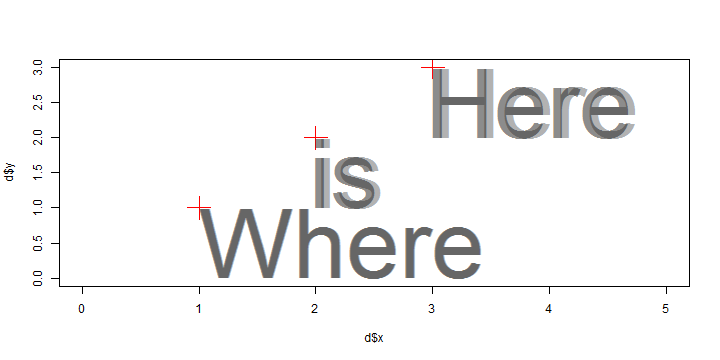The existing answer to this question is five years old, and is both useful and informative. A recent addendum to it points to a nice solution, and I think it's the best answer.
However, my answer here is to show that there was also a base R solution to the problem all along. We can see the gap on the graphical output, so all we need to do is to work out a way of getting R to see it too.
Let's say we make a plot with no margins and a black background and put a nice big letter H on it at x = 5 in white. Then we draw a thin vertical line at x = 5.
We'll create it as a png, specifying a width of 10 inches and setting a resolution of 100 pixels per inch. After its creation we can get all its pixels in an array:
mar <- par("mar")
par(mar = c(0, 0, 0, 0))
ppi <- 100
tmpfile <- tempfile(fileext = ".png")
png(tmpfile, width = 10, height = 5, units = "in", res = ppi, bg = "black")
plot(1:10, asp = 1, cex = 1)
text(x = 5, y = 10, labels = "H", adj = c(0, 1), cex = 30, col = "white")
lines(c(5,5), c(-1,20), col = "white", cex = 1)
dev.off()
mat <- png::readPNG(tmpfile)
plot(raster::as.raster(mat))
![]()
Now the array we have is monochrome, so it is actually three identical stacked matrices of 500 rows by 1000 columns. We can take a single layer of it, which will represent pixels of white (1) or black (0), each with a width of 1/100 of an inch.
So if we use apply to get the maximum value of these columns, we get a 1000-element vector of 0s and 1s that is effectively a 1-d projection of this image. The first 499 or 500 values will be 0 for the black half of the image, then there will be a single value 1 representing the white line, then zeros where the left-sided gap is before our letter, and then a run of 1s for the letter itself. If we count the black pixels between the line and the letter, we get the size of the gap.
space_in_pixels <- diff(which(apply(mat, 2, max) > 0.9))[1]
space_in_pixels
#> [1] 40
Since we can use strwidth to get the total glyph width, we can work out what proportion of the glyph is taken up by the gap on the left:
space_in_inches <- space_in_pixels / ppi
leading_proportion <- space_in_inches/strwidth("H", cex = 30, units = "inches")
leading_proportion
#> [1] 0.1106628
When you think about it, this is exactly the number that you need to provide to adj to shift the letter so that its leftmost pixel aligns with the given value of x in the call to text.
We can repeat this for all uppercase and lowercase letters (it only takes a few seconds), and store all the values in a named list.
sizes <- numeric(52)
l <- c(LETTERS, letters)
for(i in 1:52)
{
tmpfile <- tempfile(fileext = ".png")
png(tmpfile, width = 10, height = 5, units = "in", res = ppi, bg = "black")
plot(1:10, asp = 1, cex = 1)
text(x = 5, y = 10, labels = l[i], adj = c(0, 1), cex = 30, col = "white")
lines(c(5,5), c(-1,20), col = "white", cex = 1)
dev.off()
mat <- png::readPNG(tmpfile)
space_size <- diff(which(apply(mat, 2, max) > 0.9))[1]/ppi
sizes[i] <- space_size/strwidth(l[i], cex = 30, units = "inches")
}
leading <- setNames(as.list(sizes), c(LETTERS, letters))
To make this easier to use, we define a function that we can feed to adj with any given string that will shift the string to the left by the correct amount:
Adj <- function(x, y = 0)
{
first_char <- substr(x, 1, 1)
c(leading[[first_char]] * strwidth(first_char)/strwidth(x), 1)
}
So now let's try it out:
par(mar = mar)
string <- "H"
plot(1:10, asp = 1, cex = 1)
points(x = 5, y = 5, pch = 3, cex = 3, col = 'red')
text(5, 5, labels = string, cex = 8, adj = Adj(string), col = rgb(0.1, 0.9, 0.1, 0.5))
![]()
and with a multi-character string:
string <- "Xerxes"
plot(1:10, asp = 1, cex = 1)
points(x = 5, y = 5, pch = 3, cex = 3, col = 'red')
text(5, 5, labels = string, cex = 8, adj = Adj(string), col = rgb(0.1, 0.9, 0.1, 0.5))
![]() ...and a lowercase string:
...and a lowercase string:
string <- "lol"
plot(1:10, asp = 1, cex = 1)
points(x = 5, y = 5, pch = 3, cex = 3, col = 'red')
text(5, 5, labels = string, cex = 8, adj = Adj(string), col = rgb(0.1, 0.9, 0.1, 0.5))
![]()
Note that this result is not quite equivalent to the typographic left bearing. It only applies in its current form to the default sans font, but could be calculated for any font you wished to use.
You could also use this technique to get the space to the right of the glyph. In theory you could use these methods to control character spacing in a plot. This might make a useful small package.
Created on 2020-05-08 by the reprex package (v0.3.0)







 ...and a lowercase string:
...and a lowercase string:
cex = 1. – Kissablecex=1. From my screen, it looks like two pixels. It also looks like there are roughly 8 times that many for the larger ones (whencex = 8). Did you want to remove this bias for just "H" characters, or in general? – Domelcex=1. Do you have any ideas to remove these spaces? – Kissable